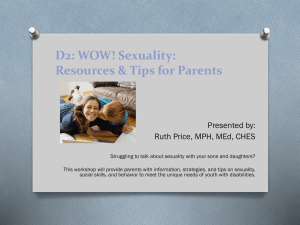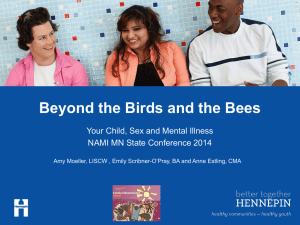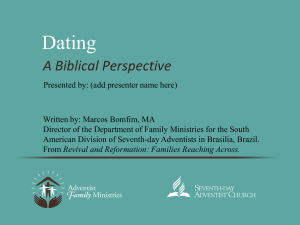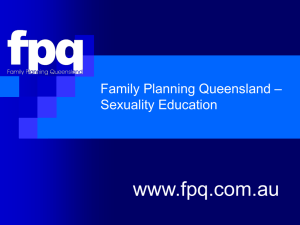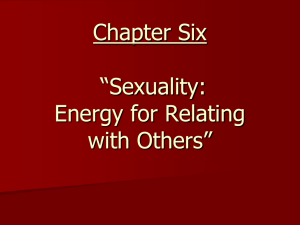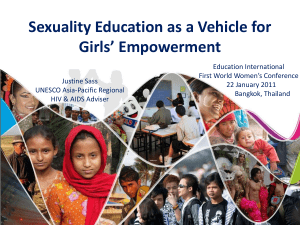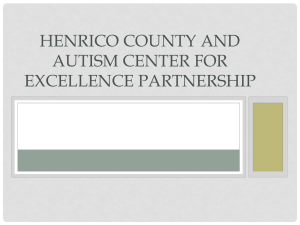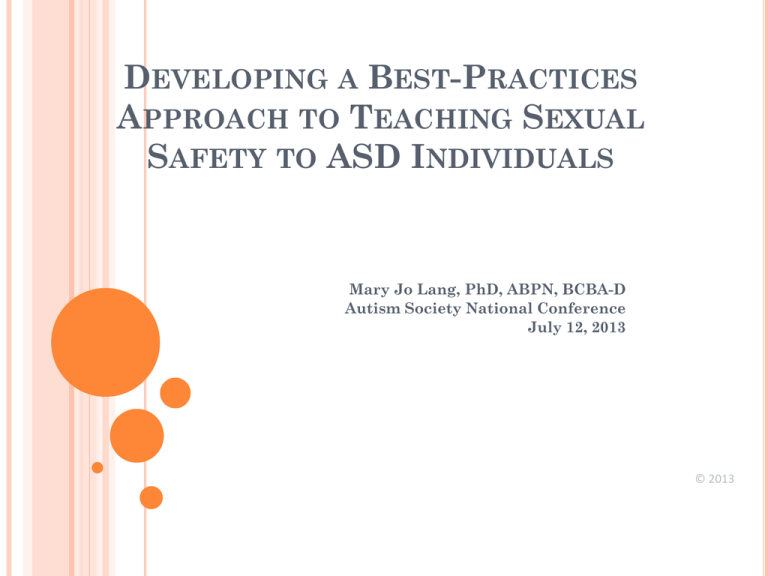
DEVELOPING A BEST-PRACTICES
APPROACH TO TEACHING SEXUAL
SAFETY TO ASD INDIVIDUALS
Mary Jo Lang, PhD, ABPN, BCBA-D
Autism Society National Conference
July 12, 2013
© 2013
OBJECTIVES
Define
sexuality.
Explore common myths.
Look at challenges in conversation.
Become familiar with key research.
Explore assessment methods.
Identify issues in sex education.
Explore instructional strategies.
Discuss social and life skills and the
role of the family.
2
OBJECTIVE 1: DEFINE SEXUALITY
3
OBJECTIVE 1
WHAT IS SEXUALITY?
Important across the lifespan
Unique to each of us
Experienced and expressed in all we are, feel, think,
and do
A basic human right
A social phenomenon
This makes this area very challenging for learners with
ASD who may have
•
•
•
•
•
•
•
•
Difficulties with communication
Impaired awareness of social cues
Limited perspective (conceptualization)
Difficulties with observational, unstructured learning
Preoccupations/obsessions
Difficulties understanding cause-effect relationships
Difficulties with sensory stimulation
4
OBJECTIVE 2:
EXPLORE COMMON MYTHS
5
OBJECTIVE 2
COMMON MYTHS
Individuals with ASD are asexual (have no
interest in sex.
Individuals with ASD are too interested in
sex (in inappropriate and uncontrollable
ways).
Individuals with ASD need to be sheltered
and protected from sexual matters.
Individuals with ASD are incapable of
learning about sexuality or participating in
sexual relationships.
Individuals with ASD do not have sexual
rights.
6
OBJECTIVE 2
IN FACT
Individuals
with ASD are sexual beings
like all persons
Can learn socially appropriate ways to
express sexuality
Can learn self-determination and selfprotective skills if given the education
and opportunity
Are capable of developing relationships
with others at many levels of intimacy
Do have sexual rights!
7
OBJECTIVE 3:
LOOK AT CHALLENGES IN CONVERSATION
8
OBJECTIVE 3
WHY IS THE CONVERSATION SO DIFFICULT?
Individuals with ASD create unique challenges
for parents and social institutions with regard to
sexuality and sex education.
The expression of sexual behavior is influenced
by various factors, such as cognitive function,
language, and support systems.
Due to the range of variability on the spectrum,
one size does not fit all when discussing
sexuality and ASD.
Sexuality is a result of the interplay of
biological, psychological, socio-economic,
cultural, ethical, and religious factors
9
(potential conflict with others).
OBJECTIVE 3
WHY IS THE CONVERSATION SO DIFFICULT?
(CONTINUED)
Candid conversations about sexuality are
difficult under the best of circumstances for most
people and can cause conflict due to different
perspectives.
Candid conversation is typically avoided or
expressed with anxiety (e.g., adolescent humor
overcompensation).
Discussions about sexual behavior can trigger
strong emotional reactions and create defensive
barriers.
10
OBJECTIVE 4:
BECOME FAMILIAR WITH KEY RESEARCH
11
KEY RESEARCH
OBJECTIVE 4
The Antwerp study (Dutch report)
Study – (1992) (n=81)
Study – (2010) (n=22, HFA)
Ruble, LA & Dalrymple, NJ (1993) Social/Sexual
Awareness of Persons with Autism: A Parent
Perspective
(n=100)
Stokes, MA & Kaur, A (2005) High-functioning autism
and sexuality: A parental perspective
HFA-neurotypical comparisons
(n=50 NT) (n=23 HFA)
Anecdotal case studies
Parent/caregiver survey
12
OBJECTIVE 4
KEY RESEARCH (CONTINUED)
ABUSE AND AUTISM
Nationwide study of 156 children with autism living in the
community over the years 1997-2000 found that:
14.1% or about one in seven had been physically abused
12.2% or about one in six had been sexually abused
4.4% had been both physically and sexually abused
Sexually-abused respondents were more likely than others
to act out sexually and/or to sexually abuse others
Mandell et al., 2005
13
KEY RESEARCH (CONTINUED)
OBJECTIVE 4
As influenced by the foregoing studies:
Sexual Behavior in Adolescents and Young Adults
with Autism (Lang et al., 2013)
Difficulties with communication
Impaired awareness of social cues
Limited perspective ( conceptualization)
Difficulties with observational, unstructured
learning
Preoccupations/obsessions
Difficulties understanding cause-effect
relationships
Difficulties with sensory stimulation
(CONTINUED NEXT SLIDE)
14
15
SEXUAL BEHAVIOR IN ADOLESCENTS
AND YOUNG ADULTS WITH AUTISM
OBJECTIVE 4
PURPOSE
National study (2013; presented at International Meeting
for Autism Research [IMFAR])
To increase normative sample size
Identify variables such as religion and culture
Parent perceptions and attitudes toward sexuality
METHODS-SURVEY
This measure identifies parents’ attitudes and perceptions of their
child, adolescent, and/or young adult’s behavior across five domains:
Social behavior (7 items)
Privacy awareness (17 items)
Sex education (17 items)
Sexual behavior (11 items)
Parental concerns (4 items)
(CONTINUED NEXT SLIDE)
16
SEXUAL BEHAVIOR IN ADOLESCENTS
AND YOUNG ADULTS WITH AUTISM
OBJECTIVE 4
(Continued)
CONCLUSIONS
Provides: Largest sample size to date regarding
sexual behavior in ASD (N=227); more diversity in
terms of region, verbal level, and autism diagnosis
(i.e. PDD-NOS, HFA, Moderate, Severe).
Inappropriate sexual behavior:
More likely to be seen in more severe diagnosis
of ASD, as well as those who are nonverbal.
Decreases with age, suggesting that primary
interventions are beneficial.
Recommendations will be discussed later in talk.
17
OBJECTIVE 5:
EXPLORE ASSESSMENT METHODS
18
OBJECTIVE 5
WHERE TO BEGIN
Determine your own level of comfort.
Determine the individual’s level of developmental
functioning.
Obtain appropriate social and developmental age
materials.
If the individual is matured physically but
delayed emotionally, then be prepared to discuss
this with teachers and others (prevention).
19
OBJECTIVE 5
DETERMINE THE INDIVIDUAL’S LEVEL OF
FUNCTIONING
What are their language and communication
skills (e.g., as derived from speech therapy)?
What are their abstract reasoning skills?
Are they hyper- or hyposensitive to visual,
auditory, tactile, smell, or taste?
Are there any additional challenges that can
impact learning?
Where is their social-emotional age as compared
with chronological age and intellect?
Use assessments and/or adaptive behavior tools
20
DETERMINE THE INDIVIDUAL’S LEVEL OF
OBJECTIVE 5
FUNCTIONING
Use the Vineland Adaptive Behavior Scale or
other adaptive behavior tools.
Use behavioral assessments for social skills,
abilities, and behavioral issues.
Use speech and language assessments for
receptive and expressive language.
COLLECT DATA!
21
OBJECTIVE 6:
IDENTIFY ISSUES IN SEX EDUCATION
22
OBJECTIVE 6
SEXUALITY EDUCATION IS…
“The lifelong process of acquiring
information and forming attitudes, beliefs, and
values about identity, relationships, and
intimacy.
It includes the biological, socio-cultural,
psychological, and spiritual dimensions of
sexuality. It addresses sexual development,
reproductive health, interpersonal
relationships, affection, intimacy, body image,
and gender roles” (SIECUS, n.d., p. 13).
23
SPECIAL CONSIDERATIONS WHEN
OBJECTIVE 6
EDUCATING STUDENTS WITH ASD
We know children with autism are often concrete
thinkers and have difficulty generalizing.
Students with autism may attend to details that are
irrelevant.
Make the answer obvious: avoid visual clutter and
provide materials that make it hard to attend to
irrelevant stimuli.
Otherwise, students may attend to nonessential
details and “miss the point.”
Teaching materials and methods must take these
characteristics into consideration.
24
OBJECTIVE 6
The goal of sexuality education should be to protect
the individual from sexual exploitation, teach
healthy sex habits, and increase self-esteem
through systematic, individualized approaches.
As a general rule
Be Clear
Be Specific
Be Concrete
Education needs to be consistent and with commonsense, on-going, constantly reinforcing appropriate
behaviors.
25
KEY OBJECTIVES OF SEX
EDUCATION
1.
2.
3.
4.
5.
6.
7.
OBJECTIVE 6
Provide information.
Foster self-esteem.
Develop attitudes and clarify values.
Teach interpersonal skills needed to achieve
mutually satisfying relationships.
Develop responsible behavior.
Develop assertiveness and self-protective skills.
Teach skills for preventing pregnancy and
sexually transmitted infections.
26
OBJECTIVE 6
INSTRUCTION SHOULD INCLUDE…
Body parts – names and use
Hygiene – how and why
Sexual awareness – what sex is and
what’s okay
Reproduction
Birth control
Sexual health
Male/female social/sexual behavior
Dating
Marriage
Abuse awareness
Boundary issues – ours and others’
Who, when, where, and how of boundaries, sex, and sexuality
Self-esteem
Assertiveness skills training
Koller,R. (2000) Sexuality and Adolescents with Autism, Sexuality and Disability, Vol.18.No. 2
27
OBJECTIVE 7:
EXPLORE INSTRUCTIONAL STRATEGIES
28
OBJECTIVE 7
BEFORE YOU BEGIN…
Decide what is most relevant and meaningful for
the individual and omit what is not.
Consider how long a skill may take to acquire
and prioritize accordingly.
Consider the age of the individual and his/her
developmental level.
Consider the natural sequence of sexual
development.
29
OBJECTIVE 7
INSTRUCTIONAL STRATEGIES
Talk about sexuality in a matter-of-fact way
This might mean practicing to get rid of your jitters and
giggles
Be positive
We don’t want to present sexuality as something bad,
wrong, or dirty
Give factual information
Remember to be matter-of-fact
Make sure you have accurate information
Be concrete
Avoid euphemisms and metaphors (e.g., “birds and bees”) make it “real” to the student.
Gear materials and instruction to the student’s
Level of understanding
Mode of communication
Learning style
Level of functioning
30
INSTRUCTIONAL STRATEGIES
OBJECTIVE 7
Present the same content in many different ways/modes,
such as these:
Pictures, line drawings
Objects, 3-D models
Videos
Role plays
Audio
Imitation
Remember that many children with autism are visual
learners.
Practice often – repetition is the key.
Keep teaching sessions brief.
Reinforce students when they behave appropriately.
Consider who is teaching, where teaching happens, and
who is around.
31
INSTRUCTIONAL STRATEGIES
OBJECTIVE 7
You can buy curricula:
Anatomically-correct dolls
Anatomical models
Written and pictorial materials
Slide shows and videos
These are rarely geared for people with ASD (and are
costly)
Images are easy to find:
Medical and nursing textbooks
Patient education materials
Sex education books for children at your library
You can also make your own materials
32
INSTRUCTIONAL STRATEGIES
OBJECTIVE 7
Focusing on teaching specific behaviors may be
more successful than trying to teach flexible
thinking that can potentially lead to many
different behaviors.
33
INSTRUCTIONAL STRATEGIES
OBJECTIVE 7
Give direct instruction, but also take natural
opportunities to practice and review skills.
Remind individuals about “the rules” before they
enter situations.
Cognitive and behavioral rehearsal
Think about how skills will be maintained over
time.
34
INSTRUCTIONAL STRATEGIES
OBJECTIVE 7
Start sexuality education young and continue it
across the lifespan
Be patient– these are complex skills!
Consider the role that mass media plays.
35
OBJECTIVE 8:
DISCUSS SOCIAL AND LIFE SKILLS & THE ROLE
OF THE FAMILY
36
OBJECTIVE 8
SOCIAL SKILLS AND OPPORTUNITIES
Building social skills is essential for independent
living and employment.
This may also lessen vulnerability to abuse.
Make the extra effort to include students with
peers in different activities.
Be creative with social involvement: hobbies,
recreation and leisure activities, extracurricular
activities, volunteering, working.
37
OBJECTIVE 8
A FEW RELEVANT SOCIAL SKILLS…
Nonverbal communication skills (eye contact, body
language, personal space)
Expression of preference
Using a telephone/computer
Turn-taking
Politeness
Paying attention
Receiving social cues
Flexibility with topics of conversation
Correcting miscommunication
Saying “excuse me”
Asking for personal space
Giving personal space
38
OBJECTIVE 8
SEXUALITY-SPECIFIC SOCIAL & LIFE SKILL TOPICS
Privacy
Boundary issues
Body part identification
Public/private discriminations
Masturbation
Nudity
Personal space
Inappropriate touching
Inappropriate comments
Indiscretion with body language
Personal appearance
Menstrual care
Self-protection
Public display of affection
Puberty – hygiene and emotional support
Sexual health care
39
OBJECTIVE 8
REMEMBER,
Developing social skills requires a lot of practice
and feedback
“Acquiring socialization skills does not happen
over night. These skills are developed across
years of observation, discussion, practice, and
constructive feedback” (NICHCY, 1992, p. 6).
40
ROLE OF THE FAMILY IS CRITICAL
OBJECTIVE 8
Parental attitudes and perceptions matter.
The family’s values should guide instruction.
Parents are often the best teachers–sexuality
instruction happens every day.
How parents respond to sexual behavior and selfexploration and how parents show affection are all
part of sexuality education.
It is important to have consistency across settings.
A great introduction to the topic: National
Information Center for Children and Youth with
Disabilities News Digest (1992) Sexuality
41
CONCLUSION
42
WHAT CAN YOU DO?
Its important to support sound research
on sexuality.
Support best practices regarding the
development of healthy, self-determined,
and safe sexuality.
Promote
opportunities for individuals to
exercise their rights and to develop
meaningful relationships with others.
43
CONCLUDING COMMENTS
Sexual
education is an emotionally
charged issue. These emotions can create
barriers to the conversations that are
needed for the benefit of those individuals
who are directly impacted. Parents,
caregivers, and teachers need to examine
their own attitudes, values, and motives
before addressing the needs of the
individual with ASD.
Thank You !
MJLang@BeaconDaySchool.com
44

